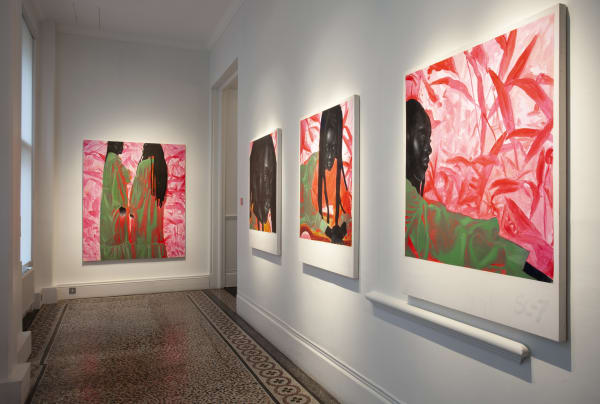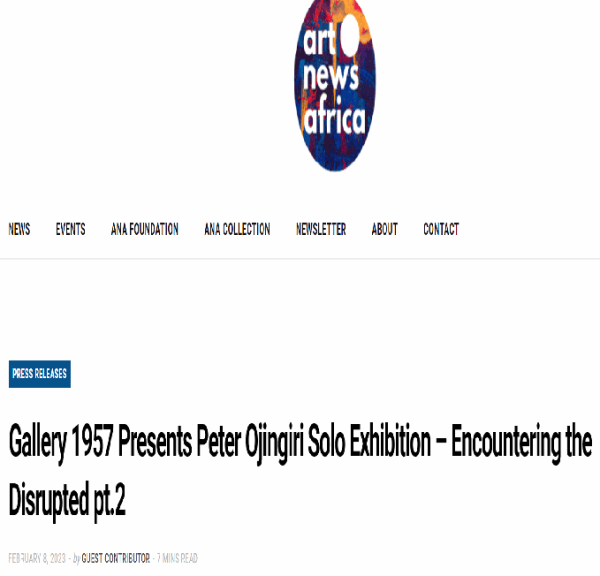Further to Peter Ojingiri’s solo exhibition Encountering the Disrupted, (Accra, 2022), Gallery 1957 is proud to present a continuation of the same body of work, expanding unto the artist’s most recent experimentations. Ojingiri deepens the subject of The Disrupted, previously defined in his paintings as those who remained home or stayed in the context of slavery and colonisation of Nigeria, as opposed to The Departed, forced to abandon the motherland.
The continuative series of large-scale paintings present the same aesthetic and visual language of the previous works as for the metallic rendering of the subject’s skin, the signature reference of the Ife head’s holes as a facial feature, the vivid magenta garden and general translucid palette of almost fluorescent greens and pinks. Encountering the Disrupted pt. 2, however, pays a new tribute to womanhood. The same repeated pair of women inhabit several paintings, perhaps sisters, easily distinguished by their different braided hairstyles. Their bond with one another and their comfortable proximity, is a reminder of Ojingiri’s desire to create, in his paintings, a safe space where the condition of being disrupted is allowed and can be embraced. More so, a space where it can be loved.
The works also manifest a new notion of intimacy accentuated by Ojingiri‘s referencing of polaroid, which exaggeratedly zoomed-in perspective and playfulness are associated with the fast and random capturing of moments of domestic privacy. The artist’s essence remains that of a storyteller. He is more interested in the viewer wondering what story is behind these figures, and more importantly, interested in the encounter itself. In his own words, his figures are simply “to be encountered in chaos and beauty.” Yet, Ojingiri’s elaboration of visual elements is everything but simple.
In this exhibition, we are introduced to this artist’s latest frontier of his dialectic on the disrupted, incorporated into “African walls.” Today’s great African cities -such as Accra, where the artist carried out this new research- are made, or we should say fragmented, of a thousand scattered and abandoned walls rarely serving a purpose. These walls are an expression of the rapid development, often without a master plan, of these large metropolises. They are the cities’ canvases, their sensitive surfaces unto which the marks left by each one remain imprinted. They are, from Ojingiri’s perspective, an urban collaborative work in the making.
After recreating the walls’ form layered by the randomness of events such as a stranger's urine or meteorological traces of the passing of time, as well as recurrent alerts about the land being “not for sale,” Ojingiri inhabits his walls with the Disrupted. He does so by transforming political posters’ faces into his characters, immediately recognizable by their nuanced evanescent way of being painted, almost evaporating.
Ojingiri’s use of political posters does not concentrate on the political narrative they carry but instead serves to develop the wall's aesthetic into the realm of painting. In this regard, the artist also says that “existing and surviving on his own is already a political act.” That also applies to the rebellious final act of ripping off the posters. Their repetition and demolition only reinforce the idea of the chaotic point of the paintings and the disrupted quality of his character as opposed to being politically engaged.
All in all, this exhibition addresses the same questions but expands their territories; it is at the same time the expansion of Ojingiri’s research on his theme, i.e., the act of encountering The Disrupted and the newly found desire for it to be developed through abstraction.
–Curatorial essay by Angelica Litta Modignani
 Peter OjingiriIn this chaotic place (polaroid 001), 2023Oil and acrylic on canvas
Peter OjingiriIn this chaotic place (polaroid 001), 2023Oil and acrylic on canvas Peter OjingiriIn this chaotic place (polaroid 003), 2023Oil and Acrylic on Canvas
Peter OjingiriIn this chaotic place (polaroid 003), 2023Oil and Acrylic on Canvas Peter OjingiriIn this chaotic place, I met you, 2023Oil and Acrylic on Canvas
Peter OjingiriIn this chaotic place, I met you, 2023Oil and Acrylic on Canvas Peter OjingiriThe neighbor’s fence, peter obi, 2023Oil, acrylic, collage paper and spray paint on canvasDiptych
Peter OjingiriThe neighbor’s fence, peter obi, 2023Oil, acrylic, collage paper and spray paint on canvasDiptych Peter OjingiriIn this chaotic place, everything feels calm, 2023Oil and Acrylic on Canvas
Peter OjingiriIn this chaotic place, everything feels calm, 2023Oil and Acrylic on Canvas














